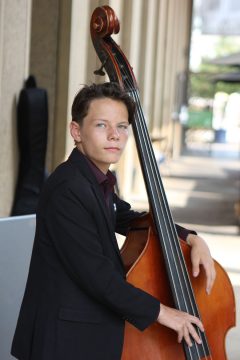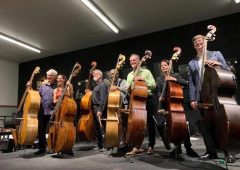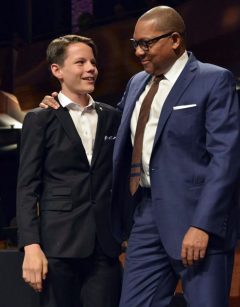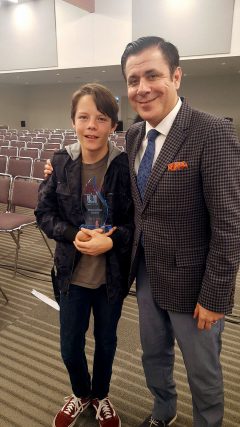Cover Story
John Murray: Heart of a Young Lion
I first heard the young bass virtuoso John Murray five years ago, when he was just 11 years old after fielding a phone call from his mentor, trumpet-master Gilbert Castellanos, who made the seemingly outlandish claim that he was “the next Scott LaFaro” (the legendary bassist for Bill Evans, who died in a car accident in 1961 at the age of 25.) Young Mr. Murray was already studying the instrument with contrabass pioneer Bertram Turetzky, the man who mentored everyone from Bob Magnusson to Nathan East. So, I ran out to catch the kid play with some of his peer group in a band, which included John’s older sister Carmen on the drums. He was really small for his age, playing a tiny instrument that seemed closer to a cello than a bass, and yet it still looked big on him. Even at that age, Murray had unlimited potential. He played in tune, had a strong quarter-note pulse, and had a substantial amount of the repertoire already committed to memory. Most of all, he and his rhythm-section sibling were crafting a groove beyond their years.
For the next few years, I attempted to explain to other jazz fans the story of this kid who could already play his tail off as a pre-teen, but I could tell people weren’t buying into it unless I showed them video or dragged them to one of the shows that Castellanos had presented under the “Young Lions” banner at Panama 66 in Balboa Park.
Meanwhile, time raced on and soon John was 13; his development had grown exponentially. He became a charter member of the Young Lions Jazz Conservatory and began attending classes at the San Diego School of Creative and Performing Arts in Paradise Hills, studying under the baton of award-winning director Dr. John Reynolds.
Before long, John’s playing was starting to gain notice on larger stages. He won “outstanding soloist” at the NextGen festival in Monterey, California, as a member of the Young Lions number-one ensemble New Soil in 2018, and he even began doing professional gigs with Castellanos and others at the age of 14.
Then, in 2019, the SCPA big-band won a spot to the Essentially Ellington competition, sponsored by Jazz at Lincoln Center (helmed by jazz superstar trumpeter Wynton Marsalis.) Hundreds of the top high school players throughout the country vie for an invitation to the competition, and the 15 best bands compete for honors in New York City. When Wynton Marsalis announced the winner of the Ella Fitzgerald Outstanding Soloist Award, he made a point of distinction: no one playing that instrument had ever won before. The crowd roared in applause when he announced the winner was John Murray, who was all of 15 at the time.
I think everyone in San Diego who watched that video stream that day joined in the cheers, or daubed a tear from their eye, or both. John also participated (for the first time) in Rob Thorsen’s semi-annual Double Bass Summit in 2019, alongside legends like Mark Dresser and Marshall Hawkins. John is 16 now, and he’s got the brightest future ahead of him that one could possibly imagine.
I’ve had the pleasure of interviewing both John and his sister Carmen several times over the years, and I’ve always been struck by the degree of humanity, maturity, and humility each one of them exudes. The future of the music is in good hands.
We’re listening for the ability to address all of the harmonic progressions with sophistication and an understanding of the harmony vertically and horizontally. And we’re listening to thematic development and an overarching concept of form. Then we’re listening to originality, feeling, anything that is unusual, even eccentric if it fills those other requirements. Then we’re listening to the overall impact the solo has on the band. We take everything seriously. We’re not gratuitous. The difference between Honorable Mention and Outstanding is the source of arguing between us… I want you to understand we have criteria.
The person who wins the award [tonight] plays an instrument that has never won it. This young man tonight is certainly playing… you all already recognized it—that’s how deep it was. I’m talking about Mr. John Murray.
—Wynton Marsalis, Artistic Director, Jazz at Lincoln Center
THE INTERVIEW
San Diego Troubadour: Do you have a recollection of the first time you heard music that impacted you?
John Murray: The first concert I attended that really stuck in my mind was Mark Dresser’s show at the San Diego Museum of Art with Bert Turetzky and eight other bassists. I remember seeing all of those basses together and the different sounds they got out of their instruments, and I remember thinking, “I want to do that.” So, I asked my parents if I could play the bass, and they were a little reluctant, because it’s such a large instrument, and I was such a little kid. But they eventually gave in. I think I was seven or eight at the time.
SDT: What was the attraction for you?
JM: The bass, for me, when I first started playing it and listening to it, had such a rich, earthy tone. And that’s something I really admired from a lot of my favorite players. I tried to emulate that. I was always just in love with that deep rich tone the bass had.
SDT: I remember your first bass. It was tiny because you were still so small. Did that make getting a big sound more of a challenge?
JM: That first instrument was a quarter-size bass and I was still too small for it. I had to stand on stools just to reach it. I remember wondering why I couldn’t get that big sound like Christian McBride. I tried to make my hand move just like his, but the big sound wasn’t coming out.
SDT: I heard you’ve acquired a new instrument. Tell me about it.
JM: It’s a three-quarter size bass. I actually had a half size before that, and it was pretty decent. But I heard about this from Rob Thorsen. It’s a Juzek and it’s a whole world of difference when you play a bigger instrument, because the sound has so much more room to grow and you can put so much power in your tone. And I think that’s something I had been missing for a while until I got that bass.
SDT: Well, you’re in good company. Ron Carter, Buster Williams, Viktor Krauss, and Mark Helias all play Juzek basses. Okay, moving on, how much of a big deal was it to have a big sister who plays the drums?
JM: For sure. Carmen and I love to play together. We’re always helping each other out and giving each other ideas. It’s just great to have an in-house drummer that I can always ask to try out things [with]. It’s been a huge advantage.
SDT: I forgot to ask, was the bass your first instrument?
JM: I was taking piano lessons when I was like four or five, but I was never really into it. I kind of viewed it as something I had to do rather than something I wanted to do. And I don’t know if it was the instrument or just that I was four. But as soon as I started playing bass, I just fell in love with it, and I’ve never really played an instrument that I like as much as the bass.
SDT: Do you remember that piano training though? Because that’s some useful stuff.
JM: Yes, it was definitely helpful to play the piano at an early age because it taught me the fundamentals of music theory, which is really important because now I can just kind of sit down at the piano and work something out that’s been going through my mind, which might be giving me a problem on the bass. It’s great to have a canvas right in front of me where I can work things out on.
SDT: Do you think you would have discovered music to the extent you have if it weren’t for the support and example of your parents?
JM: I think my parents did play a huge part in my love for jazz and that type of music because they were big jazz fans when I was growing up. So, I grew up listening to all the jazz classics, all the standards, and we would listen to them while we were eating dinner or just sitting around. And I grew up loving jazz and I got immersed in the vocabulary, so I knew what it was supposed to sound like. Also, my paternal grandmother used to play the piano and sing. She did gigs around Carlsbad and San Diego.
SDT: If I’m not mistaken, didn’t you start out playing classical music once you started on the bass?
JM: Yeah. I started off by auditioning for the New Youth Orchestra, which was run by John Ramirez and his brother Miguel Ramirez. That’s where I learned to play the bass. It really refined my technique, and they helped me in terms of reading music, bow technique, and fingerings.
SDT: If my math is correct, you were about eight years old at that point. Is this when you started studying with Bertram Turetzky?
JM: It was pretty amazing to learn from someone with as much experience as Bert has. I would go to him every Saturday. He totally refined my practicing. I was practicing obsessively and he kept me motivated and he’s one of the best teachers I’ve ever had.
I reached out to Bertram Turetzky in hopes that lessons would keep John on the classical track and also help him with his jazz studies. Being the world-class performer and educator that he is, he changed John’s life (and mine.) He advised me not to push John too hard, as long as he was keeping up with practice assignments; it was better to let him have fun and choose what type of music he wanted to play, which was jazz. When John was 11, we took him to Gilbert Castellanos’ Young Lions Series at Panama 66. Gilbert has been John’s mentor ever since. We feel exceptionally lucky to have him in John’s life. He’s been sitting in with Gilbert at his weekly jam session. As his father, I’m always looking to guide, teach, and protect him, but sometimes I’m able to step away from my role as a parent of a now teenage boy, look to the stage and watch as he moves me, and others, by doing what he loves.
—Craig Murray (John’s dad)
SDT: Did you have role models in terms of jazz bass players at that point?
JM: When I was about 12, I really idolized Paul Chambers. He wasn’t the flashiest or most technically advanced player, but he could make a band sound 10 times better than it was. He had great tone and he never played any notes that weren’t necessary. And I really admire Christian McBride—he’s got incredible technique; he can play really fast and he has a great tone. And lately, I’ve been really into Ron Carter. He’s the master of comping, of playing behind people, especially the stuff he played with Miles Davis. I just love to listen to him. I’ve transcribed a bunch of his lines and I really love what he does.
SDT: So, what led you into jazz full time?
JM: We went to Panama 66, because we heard that there were a group of kids playing there, and I met Gilbert Castellanos and I met Rob Thorsen, and all of the kids that were playing there. I just fell in love with the vibe they had there and all of the people. I started studying with Gilbert, and that was just incredible. I mean, I learned so much so quickly.
SDT: Let’s go into that a little deeper. I would imagine that Gilbert has been a huge influence on you?
JM: He’s just an incredible teacher. He shows you what it’s like to be a gigging musician. He knows that it takes a lot of work to be on the scene and he really pushes you to be the best you can possibly be a musician and as a person. I can’t thank him enough for everything he’s done for me, and almost every kid that’s playing jazz in San Diego. I remember when I was really young, I would hear Gilbert and his band play, and I would just be completely blown away by how together they were and how well they fed off each other. I remember thinking I wanted to play like that, and I wanted to be in that band. And the first time he called me for a gig with him, I was just unbelievably excited. Could not believe it. I mean, I was also really scared. I knew I had to put in the work, and he knew that putting me in that position would push me. And that’s what makes him such a great teacher.
I saw the potential and the natural talent that he had. I think that John is developing his own voice. He’s so mature for his age, musically speaking. Obviously, he’s had a great upbringing. His sister, Carmen, kind of led the way, and I think that having the Young Lions there for him has made a big difference. He’s on the roster for gigs with my group, and he has been since he was 15. I got my first gig as a leader at the Jazz Bakery last year to do a Kenny Dorham tribute, and the owner, Ruth Price, wanted to know who’d be in my band. I told her I’d be bringing John, and she asked me, “Are you sure?” I had called [saxophonist] Teodross Avery for the same gig, and he said, “Who’s in the band?” I told him Joshua White on piano, Tyler Kreutel on drums, and a 15-year-old bassist from the Jazz Conservatory. There was dead silence on the other end of the line! But, sure enough, John showed up—he was totally professional, knew the material, played his heart out, and knocked it out of the park!
—Gilbert Castellanos, founder and artistic director, Young Lions Jazz Conservatory
SDT: You spend so much time studying music and practicing. Is there ever any time to just be a kid? Do you do stuff outside of music for fun?
JM: I do love playing music. So, music is what I do for fun. But I also really love to surf—so I’ve been surfing a lot. And I like to hang out with my friends and listen to music and just have a regular high school experience because that’s something I don’t really want to miss out on.
SDT: I’ve been following your career from a distance, and I know that you won a pretty serious award a few years ago at the NextGen competition in Monterrey as a member of the Young Lions Jazz Conservatory ensemble New Soil. Can you talk about that?
JM: That was like the first major award I had ever won in terms of a prestigious high school festival. I didn’t expect to win at all. I mean, I was already having an amazing day just being in Monterey with my friends, hearing amazing music, and watching my heroes play. When they called my name for the outstanding soloist award, I was completely blown away because I thought I was way below everyone else in terms of skill level.
SDT: Right around that time, you transferred to the San Diego School of Creative and Performing Arts. What was that like?
JM: That was a pretty big switch for me, because I had previously gone to a fairly normal middle school in Balboa Park. I was one of the few kids there who really played music or listened to a lot of music. I didn’t really have any friends that shared my love for music. Then I went to SCPA, and everyone is in love with their art. The dancers, they all love what they do. The musicians love what they do. Everybody has their thing that they love to do. And I think it’s really beautiful that we can all come together and share our passion for art.
SDT: What kind of mentor was John Reynolds?
JM: John Reynolds was a great teacher. He was able to take a band that had little to no experience with performance or sight-reading music or playing these difficult tunes. And he would just start from square one. And he builds those way up from the beginning of the year into this incredible band. He was amazing with these kids who hadn’t really played music before because he would get them to fall in love with the music. And he was an amazing mentor and incredible teacher for all of us.
SDT: We’ve been building up to this question. Last year, you pretty much killed it with the SCPA band at the Essentially Ellington competition, sponsored by Jazz at the Lincoln Center. They find the top 15 high school bands in the country and you won the prestigious Ella Fitzgerald Outstanding Soloist Award. That was presented to you by Wynton Marsalis, who had some very nice words for you. Can you describe how that felt?
JM: Even almost a year later, it still doesn’t feel real, because I grew up watching Wynton play and talk and really idolizing him as this master of the music. And to hear him saying those really kind words about me… I mean, I’m such a huge fan; he’s such a master of his instrument and he’s so incredibly smart. I’ve looked up to him my entire life as someone I want to be like. And to hear him say such positive things about my playing was really incredible. I’ve never experienced anything like that.
In my 20 years of education, I have had the pleasure of being a small part of many young musicians’ journeys. When I first met John Murray, who at the time was only 13, it was clear that he had all the makings of a jazz virtuoso –sound, technique, time, and years beyond his age. The depth and clarity of his musical ideas represent the jazz art form at its highest level. It is evident to me that he developed his musical prowess through many hours of focused and thoughtful practice, shoring up his weaknesses in a logical manner. More important than his musical abilities, however, is his personhood. John is an intelligent, affable, and kind young man who possesses great humility and a wonderful sense of humor.
—John Reynolds, D.M.A. Orange County School of the Arts
SDT: With all of these accolades, how do you keep yourself grounded?
JM: Well, I just listen to the great, amazing bass players that are out there in the world. And I remind myself that I’m 16 years old and I have a really, really long way to go and I can never stop working because there’s always room for improvement.
SDT: Do you ever worry, that you might be peaking too early?
JM: I do think about that sometimes. But I believe the best way to address that is to do something about it because, you know, the future is in my hands. I can either peak now and be a great 16-year-old bass player, or I can keep working and be a great 18-year-old and 20-year-old. And so on and so forth.
SDT: What do you want to be doing in the next few years?
JM: I’m hoping to go to college for music because I think a lot of them have a great faculty and it’s a great way to improve. It’s kind of like a hub for musicians who are trying to get better at their instruments and music in general.
SDT: Do you have a list of places you will apply for your senior year?
JM: Yeah, I have some ideas. I’d like to go to New York. That’s kind of every musicians’ dream—it’s the center of the jazz universe—everyone goes to learn and to play. That’s also where all the biggest clubs are, so I have a lot of interest in New York City. But I’m also interested in Michigan State University because they have an incredible faculty with [bassist] Rodney Whitaker and [trombonist] Michael Dease and other fantastic musicians.
Here’s a little taste of John in concert.
POST SCRIPT
I remember well the moment Gilbert Castellanos alerted me to the unlimited potential of the then 11-year-old John Murray with the provocative prediction that he was “the next Scott LaFaro.” Five years later, that prediction doesn’t seem preposterous at all. I thought the most prescient comment I came across while putting this article together again came from Mr. Castellanos, one of the most sober judges of emerging talent. When I reminded him about the earlier quote, Gilbert modified his original statement thusly: “I think he’s going to be the next John Murray.”
The year 2020 has been one for the books, if nothing else. So much loss and suffering. The jazz world has been struck particularly hard. On September 4, the masterful bassist Gary Peacock passed away at the age of 85. Gary played with everyone from Bill Evans to Miles Davis, from Albert Ayler to Keith Jarrett. The loss I feel from his passing is mitigated by the fullness of his life and I find solace in the burgeoning of a talent as profound as John Murray. I can’t wait to hear what he brings to the table next.
Many thanks to Jeff Motch for allowing us to take photographs at Panama 66.











